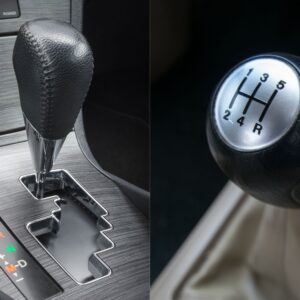Consumers choose cars by carefully considering factors like cost, resale value, performance, and utility. But among these factors, fuel consumption is definitely one of the more important ones.
With fuel prices on the rise, drivers are more likely to go for vehicles that can help them save money at the pump. This then sparks the long-standing debate of whether a manual or automatic vehicle is the way to go.
Understanding Fuel Consumption
Fuel consumption is the amount of fuel an average vehicle consumes to reach a certain distance. It’s typically expressed in liters per hundred kilometers or gallons per hundred miles (for countries that use the imperial system).
When talking about fuel consumption, lower rates mean more savings at the pump.
For example, a vehicle that consumes five liters of fuel per hundred kilometers is more efficient and environmentally friendly than another vehicle that consumes 10 liters of fuel when covering the same distance.
Generally, new cars have better fuel consumption numbers than old ones. But regardless of whether you’re driving a new or old vehicle, fuel consumption is greatly affected by driving habits and other tangible factors.
Approximately 3% to 11% of a vehicle’s fuel consumption numbers are used to overcome rolling resistance, which means that a small portion of fuel isn’t directly used to propel the vehicle.
Rolling resistance refers to the type of friction or force that goes against the movement of a rounded object, such as a tire.
Tire performance makes up about 5 to 15% light duty fuel consumption. In addition, drivers can see a 3% improvement in overall fuel consumption with a set of properly inflated tires, according to data from the US Department of Energy.
In other words, taking off from a standing stop or slowing and re-accelerating in traffic requires more energy and uses a lot more gas than cruising down the highway, thus the poor fuel economy most vehicles (except hybrids) will exhibit in town. A vehicle that will get 24 miles per gallon on the highway may only get 12 mpg in town for that reason.
Fuel Consumption vs. Fuel Economy
Fuel consumption and fuel economy are terms that are often used interchangeably even though they’re entirely different concepts.
While fuel consumption refers to the amount of fuel used when traveling to a certain distance, fuel economy pertains to the distance a vehicle can travel per unit of fuel (kilometers per liter or miles per gallon).
Fuel consumption and fuel economy have an inverse relationship. While low numbers are preferred for fuel consumption, high figures are indicative of a good fuel economy rating.
Three driving cycles dictate a vehicle’s fuel economy rating一city, highway, and combined. The fuel economy ratings of vehicles are based on a harmonic average.
This means that car companies can use all of their models to balance out fuel economy ratings, which can leverage the units that don’t sell as much. As a result, the actual fuel efficiency rating of the average vehicle decreases.
What Is the Average Fuel Consumption of a Car?
The average fuel consumption of a vehicle will depend on its type and other specifications, so there aren’t exactly hard and fast rules regarding this matter.
For example, a small hatchback should average at about six to seven liters per hundred kilometers while mid-size SUVs consume a bit more fuel while covering the same distance, which should be around eight or nine liters.
Meanwhile, dual cabs or four-wheel drive vehicles with diesel engines average at about 10 liters per hundred kilometers.
Fuel Consumption and Efficiency: Manual vs. Automatic
While it’s true that the type of transmission your vehicle plays a crucial role in producing fuel consumption numbers and fuel efficiency ratings, it should be noted that there are more factors at play here.
Are Manual Transmission Vehicles More Fuel Efficient than Automatic Transmission Vehicles?
Manual transmission vehicles being more fuel efficient than automatic ones has been a popular opinion for the longest time.
One of the most significant factors in older vehicles is the direct connection between the engine and the transmission via the clutch on a manual transmission vehicle. When a fifth “overdrive” gear is added that spins the final drive faster than the engine, fuel economy greatly increases.
Automatic transmissions in older cars wasted a lot of energy that wasn’t directly sent to the transmission due to the torque converter’s fluid coupling. There is no mechanical connection between the engine and the transmission on an older automatic without a lockup converter.
But beginning in the late 1980s, automatic transmissions began to be outfitted with lockup torque converters, which will, in 3rd gear, apply to provide a direct connection between the engine and the transmission input. When an overdrive range was added (4th gear), the difference between manual and automatic transmission fuel economy dwindled to insignificance.
Are Automatic Transmission Vehicles More Fuel Efficient than Manual Ones?
Today, automatic vehicles can deliver great fuel consumption results due to their efficient gear ratios when running at low speeds.
Modern automatic vehicles use the most efficient gear ratio possible, so reduced fuel consumption is already integrated into their systems by design.
Also, fuel consumption in automatic vehicles can be reduced even more if they’re equipped with advanced safety features like stop-start technology, adaptive cruise control, and electronic transmission systems, among others.
As for manual vehicles, reduced fuel consumption is evident when driving in a higher gear at a lower RPM than driving in a lower gear at a higher RPM.
Knowing how to handle the stick the right way also poses other benefits outside of fuel consumption, including reduced exhaust emissions and a smoother acceleration.
Other Factors Affecting Fuel Consumption
Aside from the type of transmission or gearbox your vehicle has, other factors that generally affect fuel consumption numbers include driving habits, vehicle age, and maintenance practices.
Driving Habits
Generally, a person with an aggressive driving style tends to use more fuel by harshly stepping on the accelerator pedal or by erratically accelerating and decelerating while driving on the highway. Some people do this without realizing it.
Furthermore, a vehicle driving 55 miles per hour has 40% less wind drag than it has driving at 65 mph.
On the other hand, a relaxed driving style and gentle acceleration can significantly reduce fuel consumption.
Vehicle Age
Older vehicles are more likely to use up more fuel than new ones. Old automatic vehicles were built with only around three to four gears, making it difficult to keep the engine operating at an optimal RPM range.
Meanwhile, old manual transmission vehicles won’t usually have the same issues since drivers have the freedom to shift gears until the engine reaches its optimal RPM range.
Maintenance Practices
A vehicle will only run as well as you want it to if you’re up to date with maintenance tasks such as oil changes, tire replacements, and frequent check-ups.
If the engine becomes weaker due to poor maintenance, you’ll apply more throttle to do the same work, negatively affecting fuel economy. Even keeping your tire pressure at the proper level can make a significant difference.
Poor maintenance practices can cause crucial parts like oxygen sensors, spark plugs, and fuel injectors to fail or develop issues that can lead to increased fuel consumption.
In addition, driving with underinflated tires can also increase drag and cause your vehicle to consume fuel at a shorter distance than normal.
If the engine becomes weaker due to poor maintenance, you’ll apply more throttle to do the same work, negatively affecting fuel economy. Even keeping your tire pressure at the proper level can make a significant difference.
– Richard McCuistian, ASE Certified Master Automobile Technician
Where to Get High-Quality Motor Oil
Regardless of what type of transmission your vehicle has, you’ll have to get an oil change every now and then. The exact interval can vary depending on your vehicle’s year, make, and model, but most manufacturers recommend changing your vehicle’s oil every 7,500 to 10,000 miles. Neglecting an oil change can cause the engine to break down and turn sludgy. This forces your engine to work harder just to keep the oil flowing, causing your vehicle to burn more fuel. To ensure your manual or automatic car doesn’t burn more fuel than necessary, you’ll have to change your oil regularly. Luckily, getting the right kind of motor oil is fast and easy with CarParts.com.
At CarParts.com, you’ll find a wide selection of motor oils for different types of vehicles. Our motor oils are sourced from only the most trusted manufacturers in the industry, so you can be sure you’re getting your money’s worth. If you find a competitor selling the same product as us at a lower price, let us know and we’ll match or beat their price on the spot. Our customer support team will be more than happy to assist you.
Don’t wait until your vehicle’s fuel efficiency drops before getting an oil change. Check out our catalog of high-quality motor oils at CarParts.com and get one for your vehicle today!
Any information provided on this Website is for informational purposes only and is not intended to replace consultation with a professional mechanic. The accuracy and timeliness of the information may change from the time of publication.

































